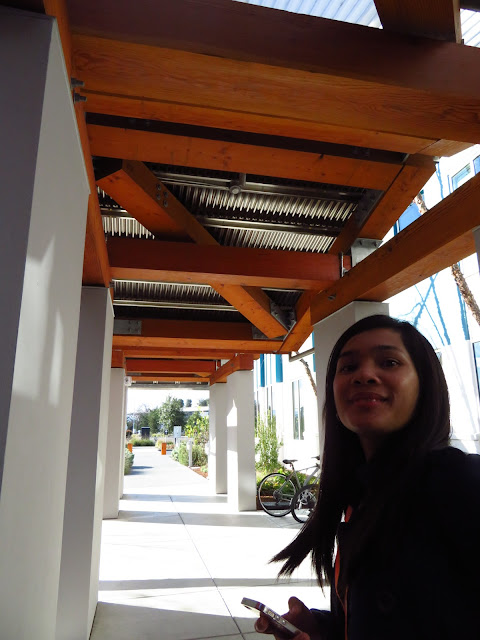Visiting Facebook HQ
I have always wondered about what it feels like to be a visitor at IRRI because I've been giving lab tours for more than a decade now and I haven't been in on a facilities tour in a long time... the exception being the Plant Growth Facility, which was inaugurated just a few months back.
So aside from my curiosity at what the Facebook HQ holds, I was excited to be a tourist for a change. Daddy's classmate from high school, Dom, invited the whole family on a field trip to the social media giant's offices in Menlo Park. His son works there as a chef; he could give us a guided tour during his downtime (before he had to be back in the kitchen). Our trip was supposed to have been scheduled way earlier; but I was benched by bronchitis so we had no choice but to delay it.
On the day itself, we were welcomed by the famous thumb's up sign that signifies "liking" posts and photos in the social media site.
We were given instructions where to park; as we neared the spot, I was wondering why there were valet services on campus. There weren't many cars at the moment... but perhaps the carpark seriously gets filled as the day goes on.
As we entered the reception area, Anna and I were excitedly observing what one of the more modern workplaces look like inside. I mean, there is a rivalry among Facebook, Google, and Apple for the best work environment (and these are just the three that I know of... Silicon Valley must have more companies vying for the best workplace title).
Facebook certainly didn't disappoint. We were greeted by well-manicured gardens, clean surroundings, and ample walking spaces. People here are obviously being encouraged to go outdoors for some exercise!

Inside Facebook's HQ, we were welcomed by Dominic, Dom's son. He was explaining the Disneyland-like layout of the campus, with a main street and lots of opportunities to get food and drink.
He was absolutely not kidding! I felt like I entered Enchanted Kingdom, a Philippine theme park that I used to frequent with the rest of the fam when we were younger. I couldn't help the comparison because the façades of the buildings were quite unreal to me. But unlike in Enchanted Kingdom, the storefronts in Facebook were actual storefronts. People could walk in to buy souvenirs, and/or grab food or drink. Then, they could claim a spot in the courtyard for a break or to continue working on their computers... or to meet up with their colleagues.
As we continued our walking tour, Anna's and Mommy's attentions were drawn to a place that gives cotton candy and other sweets. I was drawn to the Analog Research Laboratory. Dominic told us that here, people could jog their brains for creativity by working with their hands. It's a similar philosophy that was introduced via Lego blocks during the UNLEASH stage in Brenderup.
As lunch time neared, Dominic steered us towards the food stops. One of these serves barbecued meats. We passed by its rear side, though, so we first noticed the cow being zapped to the bones. I bet that the food here must have a lot of takers.
Then, we entered one of the largest dining halls I've ever seen. Dominic said that this hall could feed thousands of employees per meal service. I could just imagine how tight a ship the chefs must be running in the kitchen!
We didn't eat there, though. Instead, we ate in a different building. The chefs there were serving French cuisine on a buffet line. That's interesting, I thought. Instead, I again ended up eating vegan food. Which, I must say, was pretty tasty. Mommy was still getting a drink when I took this photo so she missed the op.
With the tour drawing to a close, we highly appreciated Dominic and Dome for spending time with us on campus and giving us the tour. We didn't see much of the work spaces (I think that these were largely off-limits) but we had a grand time seeing the exteriors and the dining spots on campus.
... and then we got to the car park. It was jam-packed! As in seriously parked full. How could we get our car out of this place, I thought. In the Philippines, this meant go back in the mall and wait until it closes before getting your car. But in Facebook, this was why there were valets everywhere. They helped move cars in this giant puzzle.
The unbelievably filled parking lot is most likely the reason why Facebook has provided bike racks for people who'd pedal their way to campus. I'd ride a bike too, if parking would be such a trouble everyday.
Alternatively, there are bikes that people can borrow if they just want to go from point A to point B without moving their cars... or if they came in via one of the tech buses.
It's a different experience, that Facebook HQ visit. But then, this is the edge of Silicon Valley, where companies sit at the bleeding edge of technology. Sometimes, though high tech, the companies do go back to analogue... like using a crane to move a full-grown pine tree to just the right spot somewhere in the middle of all those buildings.
Wow! That was quite an adventure. I wonder where our next family field trip would take us.














Comments
Post a Comment
Thank you for dropping by!
Before moving on, please share your thoughts or comments about the post. :)
Thanks again!